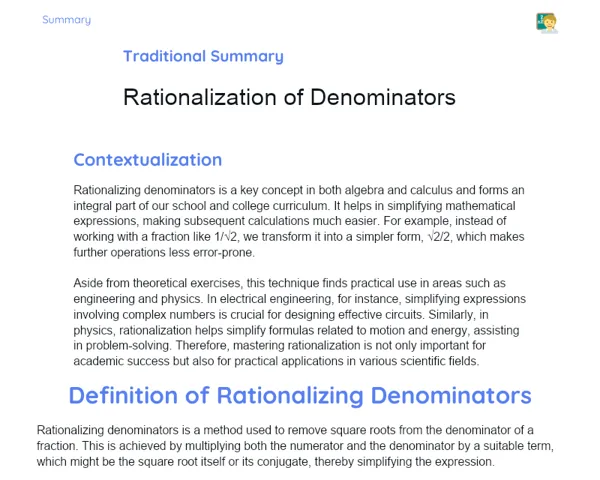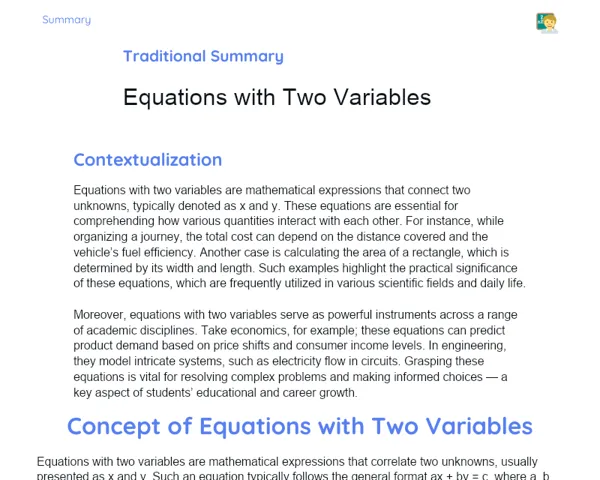Objectives
1. 🔍 Understand and apply the fundamental property that the sum of the internal angles of a triangle is always 180°.
2. 📐 Develop skills to calculate the third angle of a triangle, given that the other two angles are known.
3. 🤝 Encourage collaboration and group discussions to solve mathematical problems.
4. 🔢 Use logical reasoning and critical thinking when justifying and solving geometric problems.
Contextualization
Did you know that grasping the sum of the internal angles of a triangle is not only essential for tackling math problems but also vital in many careers and day-to-day activities? For instance, engineers rely on this understanding to design safe and durable structures, while architects use these principles to craft aesthetically pleasing and functional buildings. This geometric property is not merely a theoretical notion but a practical tool that finds applications across numerous fields and disciplines.
Important Topics
Property of the Sum of Internal Angles of a Triangle
This basic property asserts that, regardless of the triangle's size or shape, the total of its internal angles is always 180°. For example, if one angle measures 60° and another measures 40°, the third angle must be 80° to add up to 180°. This principle is the foundation for various proofs and theorems in geometry and is critical for solving problems related to triangles.
-
The sum of the internal angles of a triangle is a universal property that applies to all triangle types: equilateral, isosceles, and scalene.
-
This property can be used to verify if a shape is a valid triangle by checking the sums of all three angles to confirm they equal 180°.
-
Grasping and applying this property can simplify the solution of geometric problems and assist in practical applications, such as in engineering and architecture.
Calculating the Third Angle
When two angles of a triangle are known, the third angle can be easily found by subtracting the total of the two known angles from 180°. For example, if the two angles measure 40° and 60°, the third angle is computed as 180° - (40° + 60°) = 80°. This method is crucial for completing the information needed in various geometry problems.
-
This calculation is helpful in situations where one angle cannot be directly measured, but knowledge of the other two angles allows for determining all the triangle's measures.
-
It reinforces that the total sum of the internal angles of a triangle will always be 180°, which is a fundamental property for understanding more complex polygons.
-
It helps develop logical reasoning skills and applies mathematical properties in real-world scenarios.
Practical Applications of the Sum of Internal Angles
Understanding this property isn’t just for school—it plays a significant role in various professions such as engineering, architecture, and design. For instance, engineers use these principles to assess the stability of triangular structures, while architects apply angle sum concepts to create visually appealing and functional environments.
-
Civil engineers utilise this property when designing bridges and structures that require adequate stability, preventing potential failures or collapses.
-
In graphic design, knowledge of these properties aids in crafting visually pleasing layouts that adhere to composition principles.
-
This property serves as a crucial tool for tackling positioning challenges in geography and navigation, thereby enhancing the precision of GPS systems, among other applications.
Key Terms
-
Internal Angles: Angles formed by two sides of a triangle meeting at an internal vertex.
-
Property of the Sum of Internal Angles: The sum of the three internal angles of any triangle is always 180°.
-
Equilateral Triangle: A triangle with all sides and angles equal, with each internal angle measuring 60°.
For Reflection
-
In what ways do you think the property of the sum of internal angles of a triangle can benefit you in daily life or your future profession?
-
Why is it important for architects or engineers to deeply understand the properties of triangles?
-
Consider a real-life scenario where knowledge of the sum of internal angles could impact a significant decision. Describe the situation and how this knowledge would be applied.
Important Conclusions
-
We recall that the sum of the internal angles of a triangle is always 180°, a fundamental property that applies to a range of practical and theoretical situations in mathematics and beyond.
-
We’ve developed skills to find the third angle of a triangle when two angles are known, enhancing our logical reasoning and problem-solving capabilities.
-
We examined how this understanding is crucial in fields like engineering, architecture, and design, illustrating the real-world relevance of mathematics.
To Exercise Knowledge
- Draw three different triangles and calculate the sum of their internal angles to verify that the result consistently equals 180°. 2. Construct a small model of a house using paper strips and check if the internal angles of the triangles forming the roof total 180°. 3. Use a drawing application or graph paper to create a complex polygon and calculate the sum of the internal angles of each triangle within it.
Challenge
🚀 Architect's Challenge: Utilize the property of the sum of internal angles to design a miniature house. Sketch the project outline, including doors and windows, ensuring that all angles are appropriately calculated for a stable and visually appealing construction.
Study Tips
-
Practice sketching various types of triangles and confirming that their internal angles always add up to 180°. This will enhance your visualization and understanding of the property.
-
Engage in conversations with friends or family about how this property is applied in their work or hobbies to see real-life applications of your learning.
-
Explore online resources, such as videos and simulators, to visually delve into the sum of the internal angles and gain clarity on the concept.



